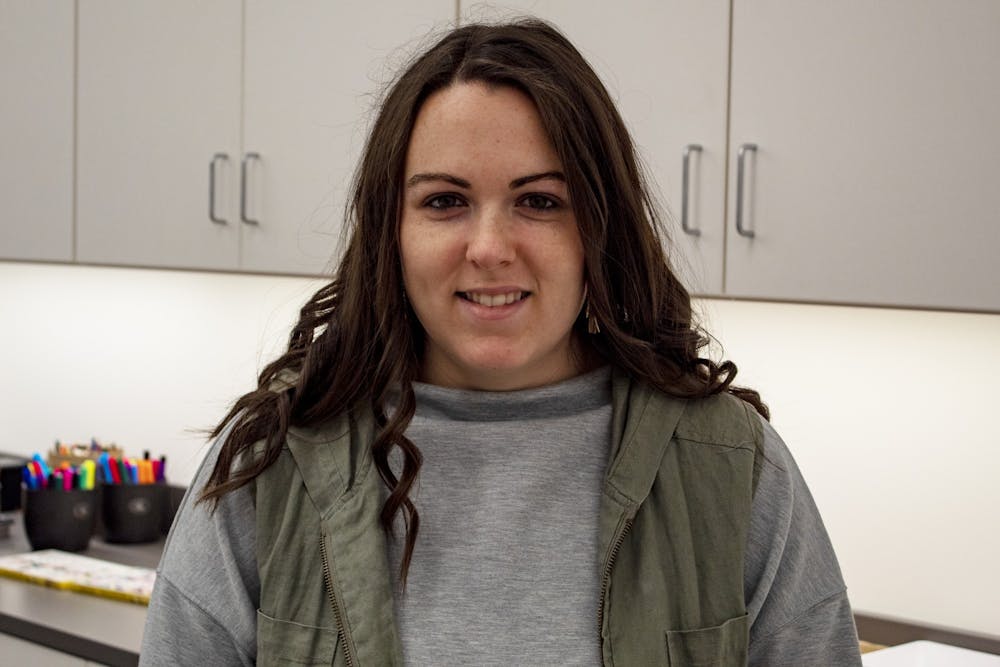Lauren Daugherty knew she had a love for art while looking at a painting during a fourth grade field trip to the David Owlsey Museum of Art. Admiring the gigantic double doors, she imagined her own work being hung on the walls.
Yes, Daugherty knows this sounds particularly idyllic. Nonetheless, her work today pushes museum guests to capture their own feelings after looking at artwork through art making.
Lauren Daugherty is an arts based wellness experiences manager at the Sidney & Lois Eskenazi Museum of Art.
“I usually just say I’m an art therapist. It rolls off the tongue a bit easier,” Daugherty said.
Daugherty received her master’s degree at the Herron School of Art and Design at IU-Purdue University Indianapolis, writing her thesis on existing museums that collaborate with art therapists and art educators.
Now, she works as an art therapist in the educational center of the Eskenazi.
Daugherty is managing the first ever arts-based wellness center at the Eskenazi. This is a result of the recently finalized $30 million renovation of the museum.
Art therapy is an emerging field. In Indiana, only three universities, IUPUI, the University of Indianapolis and St. Mary-of-the-Woods teach arts-based wellness.
Daugherty explained what art therapy looks like at the Eskenazi. She said each practitioner has a different way of providing services.
“We’re really interested in people finding their own connection with what they’re seeing,” Daugherty said. “You’re capitalizing on the magical feeling that people have when they come into a museum space.”
A wellness-based activity engages guests with art making to relax and use a creative outlet. The next step would be to analyze the art, which then becomes a therapeutic activity.
Daugherty works with elementary-age kids to college students and older community members, looking at art and then returning to the art-making studio to express their feelings through artwork.
Working with such disparate age groups requires her to understand her audience at an individual level. For example, she knows that young children may not necessarily have the same capacities as adults in analyzing and interacting with artwork.
Instead, maintaining consistency from one session to the next is key, especially for kids who have experienced trauma and instability.
For example, she works with Monroe County Career Appointed Special Advocates in helping child survivors of abuse and neglect through art therapy.
“We’re trying to really know our audience and making sure we’re using clinical skills to inform what we’re doing even if it isn’t super clinically-based,” said Daugherty.
Some of her older clients have depression, anxiety, schizophrenia or psychosis. Other clients simply want to use the resource to destress and take time for themselves.
When Daugherty first began to learn about intersecting therapy with art, she always imagined it would be in a one-on-one, clinical office or at someone’s bedside.
After a few internships, she realized that she preferred group therapy over personal settings.
“It decreases feelings of isolation,” Daugherty said. “Everything here is community-based.”
Daugherty leads three different kinds of programs since the museum’s reopening in early November: wellness pop-ups, community sessions, and college student sessions.
She organizes wellness pop-ups where she visits different schools on campus, offering wellness activities for students to participate in between classes. They often occur at the Kelley School of Business.
From 1-2:30 p.m. on Thursdays, she opens the art-making room to the Bloomington community. Following that session, from 2:30-4 p.m., she welcomes college students.
When asked about challenges in managing the museum’s first few months of art therapy, Daugherty was hard-pressed to think of any. She said her director, Heidi Soylu-Davis, had a vision for the education program, and Daugherty has had her support since her hiring.
She identified one challenge.
“It’s being able to offer the amount of services that people are wanting,” Daugherty said.
As an educational museum, the Eskenazi hires interns in many of its departments. Daugherty’s intern is Katy Bradberry, a graduate student at the Herron School of Art and Design at IUPUI.
Bradberry commented on her experiences working with Daugherty.
“It’s been a great experience here. I love working with Lauren,” Bradberry said.
Eryn Ryan, the museum’s Tour and Docent Experiences Manager also spoke about her coworker. She has worked with Lauren for about six months.
“She’s doing a great job forming personal experiences with our guests at our museum,” Ryan said. “We’re very lucky to have her.”
Moving forward, Daugherty has plenty of ideas for how the program can develop and serve more people. One idea is to create sensory tours, using 3-D printing technology to make replicas of pieces on display to better engage autistic and seeing-impaired guests.
Ultimately, Daugherty hopes to see art therapy grow as a field across the country.
Working at one of the country’s preeminent university museums as an art therapist offers great opportunity but also demands serious responsibility. Daugherty recognizes this, approaching her guests and activities alike with sensitivity and clinical research.
Daugherty has always been interested in art, art museums, and understanding human behavior. Working at the Eskenazi alongside a team of equally passionate workers has changed how she experiences museums, but nonetheless, her appreciation for her job is apparent.
“I’ve loved every second of it,” Daugherty said.
CORRECTION: A previous version of this article misidentified the university that includes the Herron School of Art. It is at IU-Purdue University Indianapolis. The IDS regrets this error.




